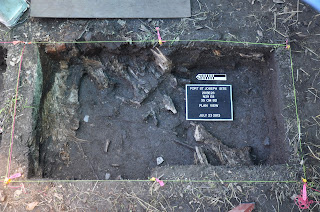Our third week working at Fort St. Joseph comes to an end, and although this is only our first whole week working at the Fort St. Joseph site since we were previously working at the Lyne site, we are already making some great discoveries. Digging progressively becomes more and more fun especially since we are all confident in our knowledge of what we are doing at this point. In our units we are using excavation techniques such as shovel skimming, troweling, and water screening.
I am
working in unit N23W9 with my pit partner, Alexis. There was a hearth found nearby, and with the
French colonial house dimensions in mind, we are hoping to find a structural
wall in our unit. Many hearths have been
found at Fort St. Joseph, so this year we are hoping to find the walls of many
of the houses that used or contained these hearths.
 |
| Che and I working in our units with a camper! |
 |
| I’m in the orange wet screening with one of the campers this week, Lucas. |
While
wet screening our dirt, an intern, James, and I found a tinkling cone. This artifact is made of copper that is
rolled into a conical shape. They served
as ornamental pieces that were attached to clothing or hair and were worn by Europeans and Indians (Hulse,
1977). Hair would be threaded through
the tinkling cone and knotted on the inside so it can be attached to clothing
or accessories such as bags, moccasins, purses, and earrings. Tinkling cones from French colonial sites are
seen all over the western Great Lakes, Illinois, and Louisiana areas. Tinkling cones were found at Native American
sites as well and some modern Native Americans today still wear tinkling cones
on their clothes or accessories. There
was little variation between tinkling cones, which suggests diffusion or
trading between different sites; although, there were slight crafting differences
between Native Americans and Europeans (Giordano, 2005).
Today
these items of adornment can tell us about the culture of those who lived at
the Fort. As archaeologists, it is our
job to not only uncover the artifacts but then to interpret them based on what
is previously known about other similar artifacts, knowledge of the site, and
time period. Artifacts can possibly
change previous perceptions about a site or suggest new discernments.
--Katie Collier
Giordano, Brock A. Crafting Culture at Fort St. Joseph: An
Archaeological Investigation of Labor
Organization on the Colonial Frontier.
Masters thesis, Department of Anthropology,
Western Michigan University: Kalamazoo, Michigan, 2005.
Hulse, Charles. An Archaeological Evaluation of Fort St.
Joseph: An Eighteenth Century Military
Post and Settlement in Berrien County, Michigan. Masters thesis, Department of Anthropology, Michigan State
University: Lansing, Michigan, 1977.
Stone, Lyle M. Fort
Michilimackinac 1715-1781: An Archaeological Perspective on the Revolutionary Frontier. East Lansing: Museum, Michigan State
University, 1974. Print.
Wise, Stacy L. An Examination of Social Identity and
Material Culture in French colonial North
America. Masters Thesis, Department of Anthropology, Western Michigan University: Kalamazoo, Michigan,
2001.






